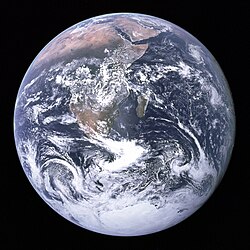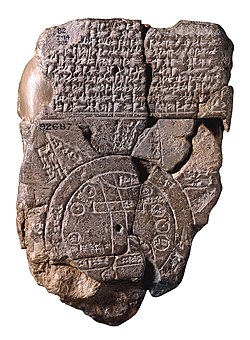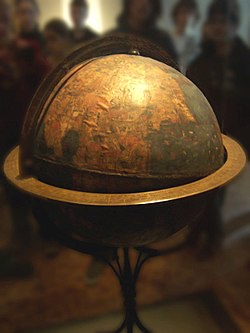-
The Imago Mundi, the oldest known world map, made no earlier than the 9th century BC Babylonia. Now in the British Museum.
-
Diagram illustrating the major categories of European classical mappae mundi.
-
Leonardo da Vinci's world map in eight Reuleaux triangle octants (1503)
-
Title page of Gerhard Mercator's atlas (1595), associating such volumes of maps with the Greek mythological titan Atlas, who rested as a mountain (see Atlas Mountains and Pillars of Hercules) at the Mediterranean world's western end to the Atlas Ocean (Atlantic), and held up the sky (not Earth; here both depicted as spheres).
-
An early hemispheric map of Earth (Nova Totius Terrarum Orbis Geographica ac Hydrographica Tabula, Hendrik Hondius, 1630)
-
Andreas Cellarius's illustration of the Earth within the celestial sphere, from the Harmonia Macrocosmica (1660)
-
Andreas Cellarius's illustration of the Copernican system, from the Harmonia Macrocosmica (1660)
-
Memorial for the second oldest international organization the Universal Postal Union in Bern, a sculpture of Earth and the personified continents by René de Saint-Marceaux (1909),[note 1] becoming in 1967 the organization's symbol.[30]
-
A modern depiction of Earth before any images from space (W. T. Benda, 1918).
-
United Nations flag (since 1947), with a circular polar projection of Earth at its center
Earth in culture
 From Wikipedia - Reading time: 18 min
From Wikipedia - Reading time: 18 min

The cultural perspective on Earth, or the world, varies by society and time period.[1] Religious beliefs often include a creation belief as well as personification in the form of a deity. The exploration of the world has modified many of the perceptions of the planet, resulting in a viewpoint of a globally integrated ecosystem. Unlike the remainder of the planets in the Solar System, mankind didn't perceive the Earth as a planet until the sixteenth century.[2]
Etymology
[edit]Unlike the other planets in the Solar System, in English, Earth does not directly share a name with an ancient Roman deity.[3] The name Earth derives from the eighth century Anglo-Saxon word erda, which means ground or soil, and ultimately descends from Proto-Germanic *erþō. From this it has cognates throughout the Germanic languages, including with Jörð, the name of the giantess of Norse myth. Earth was first used as the name of the sphere of the Earth in the early fifteenth century.[4] The planet's name in Latin, used academically and scientifically in the West during the Renaissance, is the same as that of Terra Mater, the Roman goddess, which translates to English as Mother Earth.
Planetary symbol
[edit]

The standard astronomical symbol of the Earth consists of a cross circumscribed by a circle. This symbol is known as the wheel cross, sun cross, Odin's cross or Woden's cross. Although it has been used in various cultures for different purposes, it came to represent the compass points, Earth and the land. Another version of the symbol is a cross on top of a circle; a stylized globus cruciger that was also used as an early astronomical symbol for the planet Earth.[5]
Religious beliefs
[edit]Earth has often been personified as a deity, in particular a goddess. In many cultures the mother goddess is also portrayed as a fertility deity. To the Aztecs, Earth was called Tonantzin—"our mother"; to the Incas, Earth was called Pachamama—"mother earth". The Chinese Earth goddess Hou Tu[6] is similar to Gaia, the Greek goddess personifying the Earth. Bhumi Devi is the goddess of Earth in Hinduism,[7] influenced by Graha. The Tuluva people of Tulunadu in Southern India celebrate a Three Day "Earth Day" called Keddaso. This festival comes in usually on 10th,12th,13 February every Calendar year. In Norse mythology, the Earth giantess Jörð was the mother of Thor and the daughter of Annar.[8] Ancient Egyptian mythology is different from that of other cultures because Earth (Geb) is male and the sky (Nut) is female.[9]
Creation myths in many religions recall a story involving the creation of the world by a supernatural deity or deities. A variety of religious groups, often associated with fundamentalist branches of Protestantism[10] or Islam,[11] assert that their interpretations of the accounts of creation in sacred texts are literal truth and should be considered alongside or replace conventional scientific accounts of the formation of the Earth and the origin and development of life.[12] Such assertions are opposed by the scientific community[13][14] as well as other religious groups.[15][16][17] A prominent example is the creation–evolution controversy.
Creation myths in different cultures and religions
[edit]Babylonian
[edit]Tiāmat is a sea monster known as the monster of monsters. She is killed and her body is cut in half in order to create heaven and Earth. The upper part of Tiāmat is used to create heaven with her belly as the separation line. The lower part of her body was used to create Earth, but the way that specific body parts were used to create other things is not described.[18]
Norse
[edit]Odin and his two brothers killed the frost-giant Ymir and took his body with them. From Ymir's body Odin and his brothers created the Earth. As Ymir's blood drained from his body, Odin created oceans and lakes, from his teeth they formed broken bits of rocks and placed them on mountains, from his bones they made boulders, his skull fashioned the sky and respectively his brain formed clouds. After Odin's creation of Earth he sent four dwarves down to each corner of the Earth one being Austri meaning east, another called Vestri meaning west, another named Nordri meaning north, and the final one named Sudri meaning south. This is where directions came from. Odin and his brothers then set out to make the first people. Odin and his brothers gathered wood from the seashore and created the first people, Ask being the man and Embla being the woman. Light and dark was the final step that Odin had to create. He took Night who is the daughter of a giant that is dark in color. Odin gave Night a chariot pulled by a horse called Hrimfaxi. He instructed Night to ride around the Earth and with her she brought darkness, from her horse's saliva dew was created. He then took Day, the son of Night and Delling of the AEsir, who was bright and attractive and gave him a chariot pulled by a horse named Skinfaxi. He instructed Day to ride around the Earth and with him he brought light and from his horse's mane streamed light.[19]
Aztec
[edit]In the myth of the god Tlaltecuhtli, her dismembered body was the basis for the world in the Aztec creation story of the fifth and final cosmos.[20] Before the fifth sun was created, the "earth monster" dwelled in the ocean after the fourth Great Flood. The gods Quetzalcoatl and Tezcatlipoca descended from the heavens in the form of serpents and found the monstrous Tlaltecuhtli. The two gods decided that the fifth cosmos could not prosper with such a horrible creature roaming the world, and so they set out to destroy her. After a long struggle, Tezcatlipoca and Quetzalcoatl managed to rip her body in two — from the upper half came the sky, and from the lower came the Earth. The other gods were angered to hear of Tlaltecuhtli's treatment and decreed that the various parts of her dismembered body would become the features of the new world. Her skin became grasses and small flowers, her hair the trees and herbs, her eyes the springs and wells, her nose the hills and valleys, her shoulders the mountains, and her mouth the caves and rivers.[21]
Yoruba
[edit]In the Yoruba religion, there are many gods, but the First Father is called Olorun and he is said to be perfect. Before earth was created there was only sky above and water, swamps, and mist below. One day one of the gods named Olbatala asked Olorun if he could make a world out of what was below. Olorun granted him permission to make a world from the things down below. Before taking action, Obatala consulted with another god named Orunmila (the god of divination) who told Obatala to get a golden chain and lower it from the sky to the waters below so that he could eventually return to the other gods. Orunmila also told him to take a snail shell with soil in it, a hen, a black cat, and a palm nut. Obatala heeded the god of divination's words and descended the golden chain with all of the things he was told to take. Once Obatala reached the waters below he poured all of the soil onto the water. He then set the hen down which spread the soil out by pecking and scratching at it. After the soil was spread, he planted the palm nut which grew and produced more nuts which respectively grew more trees. Obatala thought that this new world needed more light, so he consulted with Olorun who then created the Sun and Moon and sent fire on a vulture's head for light when the Sun was gone. Obatala got lonely on this new world of his, so he fashioned human beings out of clay and asked the First Father for help. Olorun breathed life into the clay figures and humans became living. Olorun also gave life to animals, plants, rivers, and language for the people to utilize. When Obatala was pleased with his work he climbed back up the golden chain and lived with the other gods in the sky above.[22]
In fiction
[edit]While in general, a planet can be considered "too large, and its lifetime too long, to be comfortably accommodated within fiction as a topic in its own right", this has not prevented some writers from engaging with the topic (for example, Camille Flammarion's Lumen (1887), David Brin's Earth (1990), or Terry Pratchett's, Ian Stewart's and Jack Cohen's The Science of Discworld (1999)[23]).[24] The iconic photo of Earth known as The Blue Marble, taken by the crew of Apollo 17 (1972), and similar images of Earth from space, might have popularized Earth as a theme in fiction.
Additionally, it is undeniable that an overwhelming majority of fiction is set on or features the Earth.[25] Earth as a planet has been subject to various works of literary treatments. Its climate itself is related to the entire genre known as climate fiction, and its future is a major aspect of the Dying Earth genre as well as the apocalyptic and post-apocalyptic fiction.[26][27][28]
Depiction of Earth
[edit]In the ancient past there were varying levels of belief in a flat Earth, with the Mesopotamian culture portraying the world as a flat disk afloat in an ocean. The spherical form of the Earth was suggested by early Greek philosophers; a belief espoused by Pythagoras. By the Middle Ages—as evidenced by thinkers such as Thomas Aquinas—European belief in a spherical Earth was widespread.[29]
Images of Earth from space
[edit]
The technological developments of the latter half of the 20th century are widely considered to have altered the public's perception of the Earth. Before space flight, the popular image of Earth was of a green world. Science fiction artist Frank R. Paul provided perhaps the first image of a cloudless blue planet (with sharply defined land masses) on the back cover of the July 1940 issue of Amazing Stories, a common depiction for several decades thereafter.[31] Earth was first photographed from a satellite by Explorer 6 in 1959.[32] Yuri Gagarin became the first human to view Earth from space in 1961. The crew of the Apollo 8 was the first to view an Earth-rise from lunar orbit in 1968, and astronaut William Anders's photograph of it, Earthrise, became iconic. In 1972 the crew of the Apollo 17 produced The Blue Marble, another famous photograph of the planet Earth from cislunar space. These became iconic images of the planet as a marble of cloud-swirled blue ocean broken by green-brown continents. NASA archivist Mike Gentry has speculated that The Blue Marble is the most widely distributed image in human history. Inspired by The Blue Marble poet-diplomat Abhay K has penned an Earth Anthem describing the planet as a "Cosmic Blue Pearl".[33] A photo taken of a distant Earth by Voyager 1 in 1990 inspired Carl Sagan to name it and describe the planet as a Pale Blue Dot.[34] On Earth Day (22 April) 2023, a collection of images to date of Earth taken from various deep space distances in the Solar System was published.[35]
Since the 1960s, Earth has also been described as a massive "Spaceship Earth," with a life support system that requires maintenance,[36] or, in the Gaia hypothesis, as having a biosphere that forms one large organism.[37] Since 2010 the Cupola of the ISS has allowed for a wealth of intricate images of Earth from orbit.[38]
Notable images of Earth from space
[edit]| Year | Event | Image | Refs |
|---|---|---|---|
| 1967 | 10 November 1967: NASA's first full-disc, true-color image of Earth, taken by the ATS-3 satellite. The image was used for the cover of the first edition of the Whole Earth Catalog the following year. | 
| |
| 1972 | 7 December 1972: the widely used The Blue Marble was taken by the crew of Apollo 17.[39] The photograph's original orientation had south pointed up.[40] |  
|
[39][41][42][43][40] |
| 1990 | 14 February 1990: the Voyager 1 space probe took the Pale Blue Dot photograph of Earth from a record distance of about 6 billion kilometers (3.7 billion miles, 40.5 AU), as part of that day's Family Portrait series of images of the Solar System. Earth appears as a tiny dot within deep space: the blueish-white speck almost halfway up the brown band on the right. Diagram of the Family Portrait showing the planets' orbits and the relative position of Voyager 1 when the mosaic was captured. |
 
|
[43][44] |
| 2010 | Family Portrait (MESSENGER) | 
|
[41] |
| 2013 | The Day the Earth Smiled - 2013 photograph of Saturn and Earth | 
|
[43] |
Impact of images of Earth from space
[edit]Over the past two centuries a growing environmental movement has emerged that is concerned about humankind's effects on the Earth. The key issues of this socio-political movement are the conservation of natural resources, elimination of pollution, and the usage of land.[45] Although diverse in interests and goals, environmentalists as a group tend to advocate sustainable management of resources and stewardship of the environment through changes in public policy and individual behavior.[46] Of particular concern is the large-scale exploitation of non-renewable resources.[47] Changes sought by the environmental movements are sometimes in conflict with commercial interests due to the additional costs associated with managing the environmental impact of those interests.[48][49][50]
See also
[edit]Notes
[edit]- ^ A postage stamp honoring the sculptor and the monument was issued jointly by Switzerland and France.
References
[edit]- ^ Widmer, Ted (24 December 2018). "What Did Plato Think the Earth Looked Like? - For millenniums, humans have tried to imagine the world in space. Fifty years ago, we finally saw it". The New York Times. Retrieved 25 December 2018.
- ^ Arnett, Bill (16 July 2006). "Earth". The Nine Planets, A Multimedia Tour of the Solar System: one star, eight planets, and more. Retrieved 9 March 2010.
- ^ Blue, Jennifer (25 June 2009). "Planetary Nomenclature FAQ". Gazetteer of Planetary Nomenclature. Retrieved 6 January 2010.
- ^ Harper, Douglas (November 2001). "Earth". Online Etymology Dictionary. Retrieved 7 August 2007.
- ^ Liungman, Carl G. (2004). "Group 29: Multi-axes symmetric, both soft and straight-lined, closed signs with crossing lines". Symbols -- Encyclopedia of Western Signs and Ideograms. New York: Ionfox AB. pp. 281–282. ISBN 978-91-972705-0-2.
- ^ Werner, E.T.C. (1922). Myths & Legends of China. New York: George G. Harrap & Co. Ltd. Archived from the original on 7 September 2008. Retrieved 14 March 2007.
- ^ "Bhumi, Bhūmi, Bhūmī: 41 definitions". Wisdom Library. 11 April 2009.
Earth (भूमि, bhūmi) is one of the five primary elements (pañcabhūta)
- ^ Lindow, John (2002). Norse Mythology: A Guide to Gods, Heroes, Rituals, and Beliefs. Oxford University Press. p. 205. ISBN 978-0-19-983969-8.
- ^ Pinch, Geraldine (2002). Handbook of Egyptian Mythology. Handbooks of World Mythology. ABC-CLIO. pp. 135, 173. ISBN 1-57607-763-2.
- ^ Dutch, S.I. (2002). "Religion as belief versus religion as fact" (PDF). Journal of Geoscience Education. 50 (2): 137–144. Bibcode:2002JGeEd..50..137D. CiteSeerX 10.1.1.404.522. doi:10.5408/1089-9995-50.2.137. Retrieved 28 April 2008.
- ^ Edis, Taner (2003). A World Designed by God: Science and Creationism in Contemporary Islam. Amherst: Prometheus. ISBN 978-1-59102-064-6. Archived from the original on 8 May 2013. Retrieved 28 April 2008.
{{cite book}}: CS1 maint: publisher location (link) - ^ Ross, M.R. (2005). "Who Believes What? Clearing up Confusion over Intelligent Design and Young-Earth Creationism" (PDF). Journal of Geoscience Education. 53 (3): 319–323. Bibcode:2005JGeEd..53..319R. CiteSeerX 10.1.1.404.1340. doi:10.5408/1089-9995-53.3.319. Retrieved 28 April 2008.
- ^ Pennock, R.T. (2003). "Creationism and intelligent design" (PDF). Annu Rev Genom Hum Genet. 4 (1): 143–63. doi:10.1146/annurev.genom.4.070802.110400. PMID 14527300.
- ^ Science, Evolution, and Creationism. Washington, DC: National Academy Press. 2005.
- ^ Colburn, A.; Henriques, L. (2006). "Clergy views on evolution, creationism, science, and religion". Journal of Research in Science Teaching. 43 (4): 419–442. Bibcode:2006JRScT..43..419C. doi:10.1002/tea.20109.
- ^ Frye, Roland Mushat (1983). Is God a Creationist? The Religious Case Against Creation-Science. Scribner's. ISBN 978-0-684-17993-3.
- ^ Gould, S.J. (1997). "Nonoverlapping magisteria" (PDF). Natural History. 106 (2): 16–22. Retrieved 28 April 2008.
- ^ Lambert, Wilfred G. (2013). Babylonian Creation Myths. Eisenbrauns. pp. 192–193. ISBN 9781575062471.
- ^ Whittock and Whittock, Martyn and Hannah (2018). Tales of Valhalla. New York: Pegasus Books, Ltd. pp. 26–28. ISBN 9781681778464.
- ^ "Tlaltecuhtli". World History Encyclopedia. Retrieved 7 October 2018.
- ^ Thevet, André (c. 1540). "IX". Histoyre du mechique (in French). pp. 31–34.
- ^ Kallen, Stuart A. (2015). Mythology and Culture Worldwide African Mythology. Farmington Hills, MI: Lucent Books. pp. 27–29. ISBN 9781420511451.
- ^ "Terry Pratchett and the real science of Discworld". the Guardian. 19 May 2015. Retrieved 4 January 2024.
- ^ Stableford, Brian M. (2006). Science Fact and Science Fiction: An Encyclopedia. Taylor & Francis. pp. 137–139. ISBN 978-0-415-97460-8.
- ^ Westfahl, Gary (2005). The Greenwood Encyclopedia of Science Fiction and Fantasy: Themes, Works, and Wonders. Greenwood Publishing Group. pp. 226–227. ISBN 978-0-313-32951-7.
- ^ "Themes : Dying Earth : SFE : Science Fiction Encyclopedia". www.sf-encyclopedia.com. Retrieved 20 August 2021.
- ^ "Themes : Ruined Earth : SFE : Science Fiction Encyclopedia". www.sf-encyclopedia.com. Retrieved 20 August 2021.
- ^ "Themes : Climate Change : SFE : Science Fiction Encyclopedia". www.sf-encyclopedia.com. Retrieved 20 August 2021.
- ^ Russell, Jeffrey B. "The Myth of the Flat Earth". American Scientific Affiliation. Retrieved 14 March 2007.; but see also Cosmas Indicopleustes
- ^ "The Postal History of ICAO". applications.icao.int. 10 July 1964. Retrieved 22 May 2021.
- ^ Ackerman, Forrest J (1997). Forrest J Ackerman's World of Science Fiction. Los Angeles: RR Donnelley & Sons Company. pp. 116–117. ISBN 978-1-57544-069-9.
- ^ Staff (October 1998). "Explorers: Searching the Universe Forty Years Later" (PDF). NASA/Goddard. Archived from the original (PDF) on 17 September 2011. Retrieved 5 March 2007.
- ^ An Anthem for the Earth Kathmandu Post, 25 May 2013
- ^ Staff. "Pale Blue Dot". SETI@home. Archived from the original on 17 August 2011. Retrieved 2 April 2006.
- ^ Kaufman, Mark (22 April 2023). "The farthest-away pictures of Earth ever taken - Our precious planet seen from deep space". Mashable. Retrieved 22 April 2023.
- ^ Fuller, R. Buckminster (1963). Operating Manual for Spaceship Earth (First ed.). New York: E.P. Dutton & Co. ISBN 978-0-525-47433-3. Archived from the original on 28 October 2004. Retrieved 21 April 2007.
{{cite book}}: ISBN / Date incompatibility (help) - ^ Lovelock, James E. (1979). Gaia: A New Look at Life on Earth (First ed.). Oxford: Oxford University Press. ISBN 978-0-19-286030-9.
- ^ "Cupola Observational Module". Archived from the original on 11 December 2020. Retrieved 27 March 2021.
- ^ a b "Milestones in Space Photography". National Geographic Society. Archived from the original on 1 April 2020.
- ^ a b Reinert, Al (12 April 2011). "The Blue Marble Shot: Our First Complete Photograph of Earth". The Atlantic. Retrieved 1 August 2018.
- ^ a b "Viewing The Earth From Space Celebrates 70 Years". Forbes. 22 August 2016. Archived from the original on 23 August 2016.
- ^ "Fifty Years Ago, This Photo Captured the First View of Earth From the Moon". 23 August 2016. Archived from the original on 25 August 2016.
- ^ a b c "60 Years Ago We Saw Earth From Space for the First Time — Here's How We See It Now". 22 August 2019. Archived from the original on 23 August 2019.
- ^ "Our home world from afar". 22 April 2020. Archived from the original on 1 December 2020.
- ^ McMichael, Anthony J. (1993). Planetary Overload: Global Environmental Change and the Health of the Human Species. Cambridge University Press. ISBN 978-0-521-45759-0.
- ^ Lester, James P. (1995). Environmental Politics and Policy: Theories and Evidence. Duke University Press. pp. 115–119. ISBN 978-0-8223-1569-8.
- ^ Lafferty, William M.; Langhelle, Oluf (1999). Towards Sustainable Development: On the Goals of Development and the Conditions of Sustainability. St. Martin's Press. pp. 30–41. ISBN 978-0-312-21669-6.
- ^ Barbera, Anthony J.; McConnell, Virginia D. (January 1990). "The impact of environmental regulations on industry productivity: Direct and indirect effects". Journal of Environmental Economics and Management. 18 (1): 50–65. doi:10.1016/0095-0696(90)90051-Y.
- ^ Jaffe, A.; Adam, B.; Peterson, S.; Portney, P.; Stavins, R. (March 1995). "Environmental Regulation and the Competitiveness of U.S. Manufacturing: What Does the Evidence Tell Us?". Journal of Economic Literature. 33 (1): 132–163. Retrieved 24 January 2009.
- ^ Moavenzadeh, Fred (1994). Global Construction and the Environment: Strategies and Opportunities. Wiley-IEEE. pp. 30–41. ISBN 978-0-471-01289-4.
 KSF
KSF








